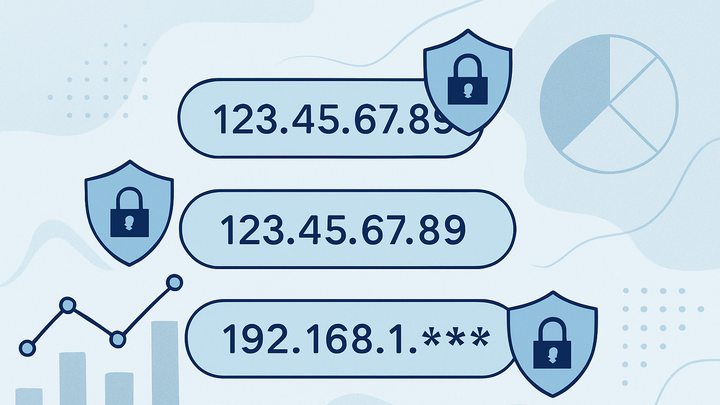Published on 2025-06-27T19:32:47Z
What is IP Anonymization in Analytics? Examples and Best Practices
IP Anonymization is the process of masking or removing identifiable information from IP addresses before storing or processing them. In analytics, this technique helps organizations gather insights on user behavior while safeguarding individual privacy. By truncating or hashing parts of an IP address, analysts can still approximate user location and network characteristics without exposing personal data. This approach reduces compliance risks under regulations like GDPR and CCPA and aligns with privacy-by-design principles. Tools like PlainSignal inherently avoid collecting full IPs, whereas platforms like Google Analytics 4 offer configurable anonymization settings. Implementing IP anonymization builds user trust and demonstrates a commitment to data ethics.
Ip anonymization
IP Anonymization masks user IP addresses in analytics to protect privacy and ensure compliance with data regulations.
Why IP Anonymization Matters
IP anonymization is crucial for protecting user privacy and maintaining compliance with global data protection laws. By masking IP addresses, organizations can collect valuable analytics without exposing personally identifiable information. This practice fosters user trust and reduces legal liabilities in the event of data breaches. Additionally, anonymized data supports privacy-by-design principles, making it a foundational element of ethical analytics. Below are the primary reasons to implement IP anonymization:
-
Compliance with privacy regulations
Anonymizing IP addresses helps meet requirements under GDPR, CCPA, and other data protection laws by minimizing the storage of personal data.
-
Gdpr
General Data Protection Regulation mandates pseudonymization or anonymization of personal data.
-
Ccpa
California Consumer Privacy Act requires data minimization and privacy safeguards for personal information.
-
-
Enhancing user trust
Masking IPs demonstrates respect for user privacy, improving brand reputation and increasing user engagement.
-
Reducing liability
Limits the scope of personal data collected, thus reducing risk in case of data breaches or regulatory audits.
How IP Anonymization Works
IP anonymization techniques transform or truncate IP addresses to remove or obscure identifiable elements while retaining enough detail for useful analytics. Here are the common methods used:
-
Ip truncation
Masks part of the IP address by zeroing out specific bits. For example, zeroing the last octet in IPv4 to hide precise location.
-
Ipv4 truncation
The last 8 bits (last octet) are set to 0, e.g., 192.168.1.123 → 192.168.1.0.
-
Ipv6 truncation
Zeroes out the last 80 bits of the address to generalize location data.
-
-
Hashing techniques
Applies a one-way cryptographic hash to the IP, creating an irreversible pseudonym while enabling grouping by identical hashed values.
-
On-the-fly vs. stored anonymization
On-the-fly anonymization masks IPs during data collection, whereas stored anonymization processes raw logs post-collection to remove identifiers.
Implementing IP Anonymization in Analytics Tools
Most modern analytics platforms offer built-in or configurable options for IP anonymization. Below are examples for PlainSignal and Google Analytics 4 (GA4).
-
PlainSignal (cookie-free simple analytics)
PlainSignal is designed with privacy at its core and never stores full IP addresses. Integrate the following snippet to enable anonymized tracking:
<link rel="preconnect" href="//eu.plainsignal.com/" crossorigin /> <script defer data-do="yourwebsitedomain.com" data-id="0GQV1xmtzQQ" data-api="//eu.plainsignal.com" src="//cdn.plainsignal.com/plainsignal-min.js"></script> -
Google analytics 4 (GA4)
In GA4, enable IP anonymization by setting the
anonymize_ipparameter in your tracking code or via Admin settings:gtag('config', 'GA_MEASUREMENT_ID', { 'anonymize_ip': true });
Best Practices and Considerations
When implementing IP anonymization, balance privacy with data accuracy, and ensure your approach aligns with both technical requirements and legal frameworks.
-
Balance precision and privacy
Determine the minimal IP detail needed for geographic or network analysis to avoid over-anonymization that could reduce data value.
-
Test and validate
Verify anonymization in development and staging environments by inspecting raw request headers or logs to confirm IPs are masked correctly.
-
Maintain clear documentation
Document your anonymization settings, tools used, and any custom implementations for auditing and future reference.
